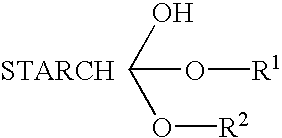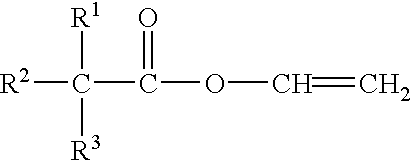Starch ester
a starch ester and starch ester technology, applied in the field of starch ester, can solve the problems of difficult to achieve molded articles having an impact resistance of 1, difficult to achieve injection-molded articles, and hardly achieve the same level of impact strength as impact strength polystyrene, etc., to achieve the effect of tensile elongation and stretchability as good as polyethylen
- Summary
- Abstract
- Description
- Claims
- Application Information
AI Technical Summary
Benefits of technology
Problems solved by technology
Method used
Image
Examples
example 2
The starch ester of Example 2 was prepared in the same manner as in Example 1 except that acid-treated regular corn starch was used in place of high amylose corn starch, and 14 g vinyl stearate (C18) was used in place of vinyl laurate.
example 3
The starch ester of Example 3 was prepared in the same manner as in Example 1 except that 16 g chlorinated stearic acid (C18) was used in place of vinyl laurate.
example 4
100 g commercial corn starch with a water content reduced to 1% or less by preliminary drying, and 800 g DMSO, were introduced into a 2 L separable flask equipped with a stirrer, then heated at 90.degree. C. and gelatinized by keeping it at this temperature for 20 minutes. After a solution of 5 g t-butyl bromide and 532 g hexadecyl ketene dimer (C17) was added dropwise thereto, the mixture was reacted at 90.degree. C. for 5 hours in a system under reduced pressure, during which the DMSO was refluxed. Thereafter, the reaction system was returned to the atmospheric pressure, and a solution of 126 g acetic anhydride and 103.8 g sodium bicarbonate was added dropwise thereto, and the mixture was reacted for 1 hour at the reflux temperature thereof. After the unreacted materials and byproducts were allowed to flow out, the product was recovered under vigorous stirring in water, and then washed repeatedly 5 times with 5 L water to prepare the starch ester of Example 4.
PUM
| Property | Measurement | Unit |
|---|---|---|
| glass transition point | aaaaa | aaaaa |
| glass transition point | aaaaa | aaaaa |
| glass transition point | aaaaa | aaaaa |
Abstract
Description
Claims
Application Information
 Login to View More
Login to View More - R&D
- Intellectual Property
- Life Sciences
- Materials
- Tech Scout
- Unparalleled Data Quality
- Higher Quality Content
- 60% Fewer Hallucinations
Browse by: Latest US Patents, China's latest patents, Technical Efficacy Thesaurus, Application Domain, Technology Topic, Popular Technical Reports.
© 2025 PatSnap. All rights reserved.Legal|Privacy policy|Modern Slavery Act Transparency Statement|Sitemap|About US| Contact US: help@patsnap.com



